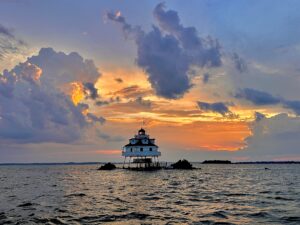Senator Van Hollen & Congressman Sarbanes Introduce Legislation to Establish the Chesapeake National Recreation Area

Photo Credit: David Sites
Washington, DC – Today, U.S. Senator Chris Van Hollen and Congressman John Sarbanes introduced the Chesapeake National Recreation Area Act (S.2620 and HR 5045), which, if passed into law, would create the Chesapeake National Recreation Area (CNRA). The CNRA would be a land-based, 21st-century park, uniting new and existing National Park Service (NPS) sites and trails, as well as partner parks, to increase public access to the Chesapeake Bay and create a national park-worthy visitor experience for all to enjoy. Co-sponsors include Senators Ben Cardin (D-Md.), Mark Warner, and Tim Kaine (both D-Va.) and U.S. Representatives Don Beyer (D-Va.), Gerry Connolly (D-Va.), Steny Hoyer (D-Md.), Glenn Ivey (D-Md.), Jennifer McClellan (D-Va.), Kweisi Mfume (D-Md.), Eleanor Holmes Norton (D-D.C.), Jamie Raskin (D-Md.), Dutch Ruppersberger (D-Md.), Bobby Scott (D-Va.), David Trone (D-Md.), and Rob Wittman (R-Va.).
One year ago, a July 2022 public opinion poll showed profound support for National Park Service status for the Chesapeake, with 83% of Maryland, Virginia and Washington, DC respondents in favor of establishing a Chesapeake National Recreation Area. A congressional working group was formed in June 2022, and draft legislation was shared in November 2022. Hundreds of public comments were submitted.
Representatives of United4CNRA, a coalition of organizations and people advocating for the CNRA, issued the following statements celebrating this significant step toward establishing the CNRA:
“Latino Outdoors wholeheartedly endorses Senator Chris Van Hollen and Congressman John Sarbanes’ vision for the Chesapeake National Recreation Area. It is a vision that has been thoughtfully crafted by a broad range of stakeholders, and it centers the protection of diverse landscapes, increased diverse public access, and the celebration of cultural diversity. We applaud the efforts of Senator Van Hollen, Congressman Sarbanes, and the entire CNRA working group. We see their actions as an affirmation of the importance of diversity, not for diversity’s sake, but rather for its potential to be a catalyst for a thriving and sustainable regional economy, community, and recreational asset. – Latino Outdoors Executive Director Luis Villa
“Thank you, Senator Van Hollen and Congressman Sarbanes, for making a more than 30-year-long dream come true. The Chesapeake Bay is as spectacular as Yellowstone or Yosemite, as great as the Great Smokies and as grand as the Grand Tetons. Establishing the Chesapeake National Recreation Area expands resources for environmental protection and makes it clear that the United States cherishes the Chesapeake, the birthplace of American identity. As a great gift to future generations, this legislation ensures everyone’s right to visit and recreate on our nation’s largest estuary while balancing the needs of those who live here and depend on the bay for their livelihood.” – Chesapeake Conservancy President & CEO Joel Dunn
“We appreciate the many years of hard work that Senator Chris Van Hollen, Representative John Sarbanes and the Chesapeake working group have dedicated to charting a path forward for the Chesapeake National Recreation Area.
“There is only one Chesapeake Bay, and everyone deserves a chance to experience its wonders. Working together to create a Chesapeake National Recreation Area would expand public access to the largest estuary in the world, bring economic growth to nearby communities, and help the National Park Service, native Tribes, and Chesapeake watermen interpret thousands of years of impactful history. Introducing legislation is the next step to make the dream of this park a reality.” – National Parks Conservation Association (NPCA) President & CEO Theresa Pierno
“The Chesapeake Bay has nourished Indigenous people both physically and spiritually for more than 10,000 years. The Chesapeake National Recreation Area would help educate our young people about the long-standing connection between the Chesapeake Bay and American Indians and ensure that the bay’s plants and animals, which are so essential to the sustaining power of life for everyone, are protected while preparing our next generation of leaders for the future.” – Rappahannock Tribe Chief Anne Richardson
“The National Park Service serves as one of our nation’s foremost storytellers and steward of our rich and diverse natural and cultural heritage. The Chesapeake National Recreation Area would allow all of the American people and our international visitors to learn about our country’s history and how the Chesapeake Bay has been the landscape of Indigenous history, European exploration, colonialism, independence, slavery and freedom.” – former National Park Service Director “Bob” Robert Stanton (retired)
###
The Chesapeake National Recreation Area Act would designate a collection of new and existing parks and public lands along the Chesapeake Bay as the new Chesapeake National Recreation Area (CNRA). Places that highlight the bay across Maryland and Virginia, such as state and local parks and wildlife refuges, could become part of the CNRA and benefit from the resources of the National Park Service to help improve the visitor experience, improve public access to the bay, protect the natural environment and tell an interesting story about our region. The CNRA will raise the visibility of the Chesapeake Bay as an important resource, encourage upcoming generations to protect the bay, create sustainable jobs, increase private investment in the bay region, add new sites to access the bay, link all the park sites around the bay with a common visitor experience and invite people to explore. www.united4cnra.org